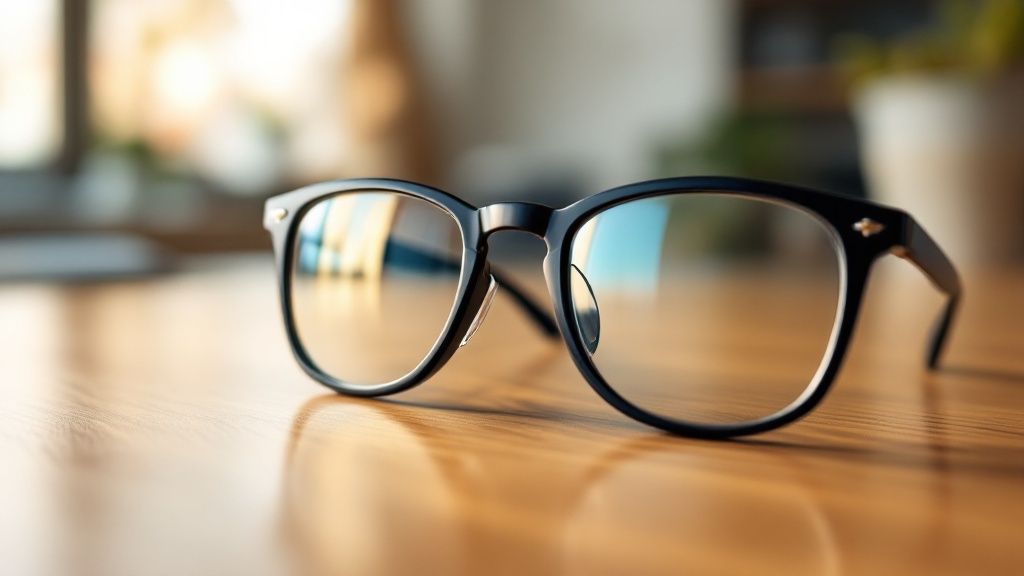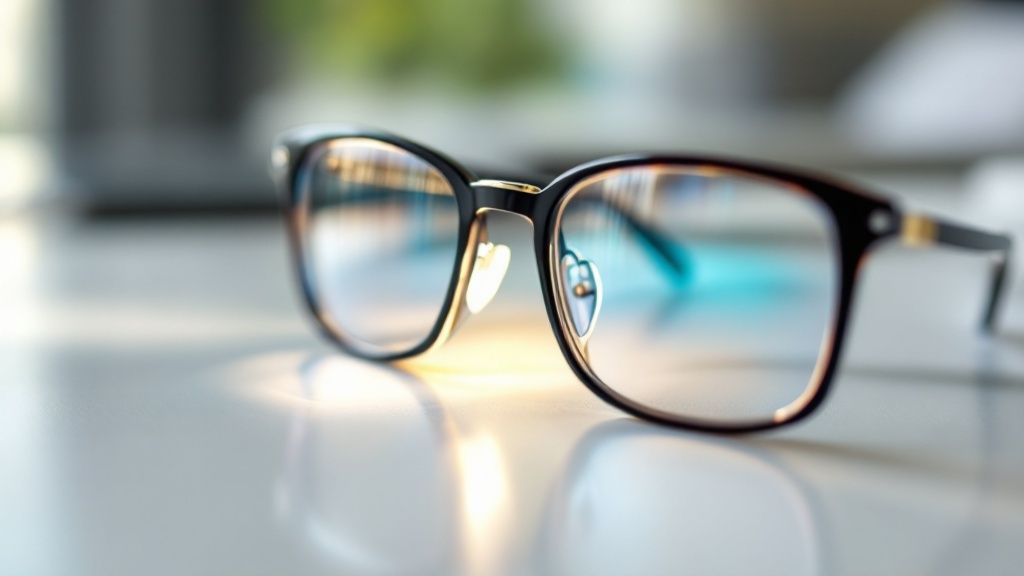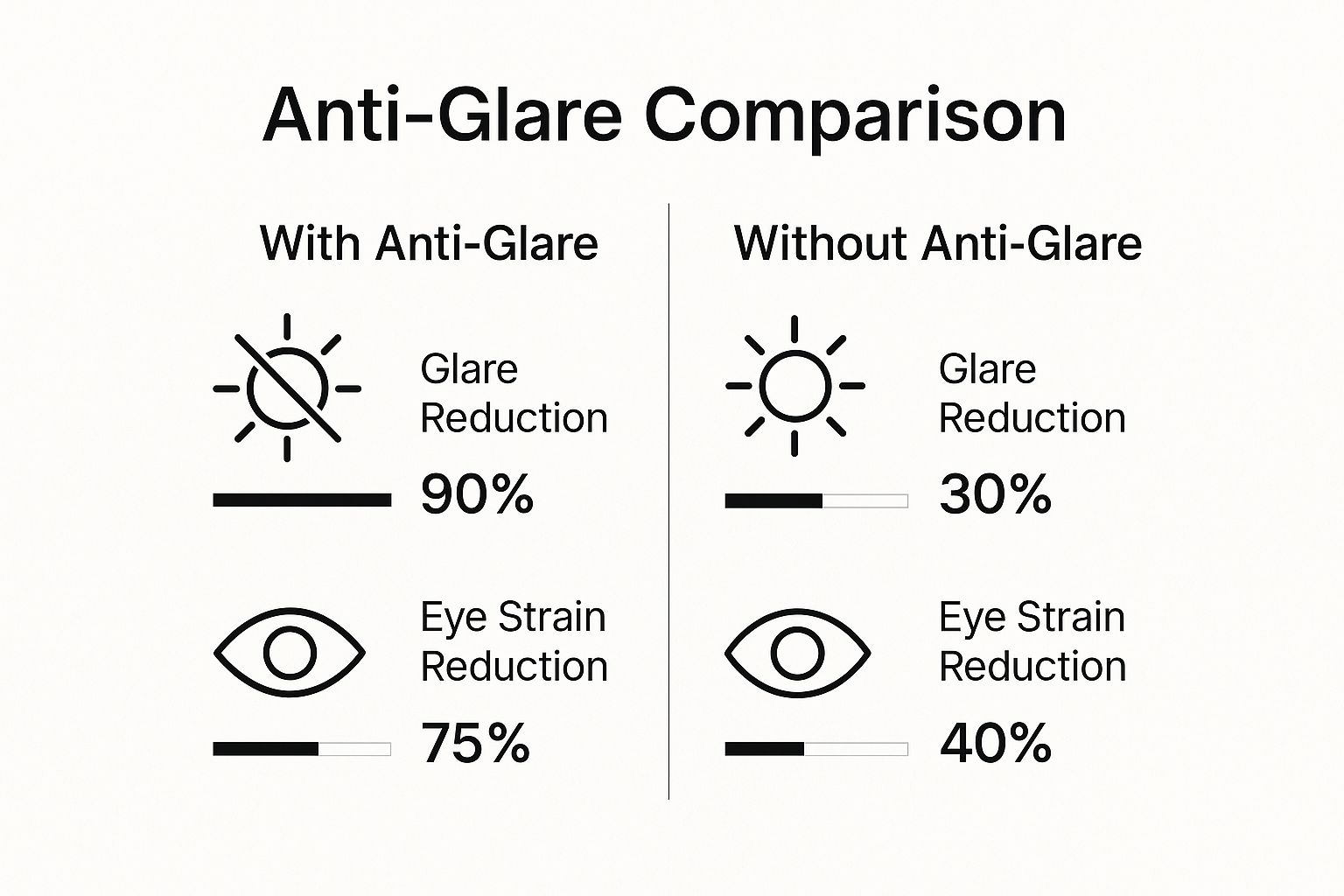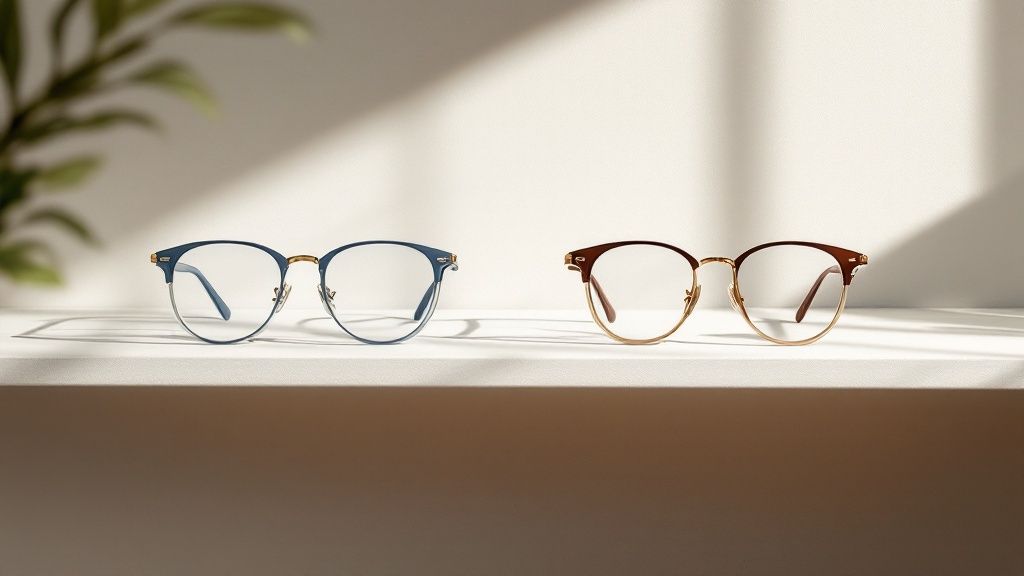
Your Guide to Anti Glare on Glasses
When you hear an optician talk about anti-glare on glasses, they're referring to a special treatment called an anti-reflective or AR coating. It’s a nearly invisible layer that’s applied to your lenses to get rid of those annoying, distracting reflections. This lets more light pass straight through to your eyes, giving you clearer, sharper vision and cutting down on eye strain.
Why Annoying Reflections Disrupt Your Vision

If you've ever had to squint through the glare of oncoming headlights or been distracted by your own reflection on a video call, you know how frustrating standard eyeglass lenses can be. These reflections are more than just a minor inconvenience—they actively mess with your visual clarity and comfort.
Think about looking into a perfectly still, clear lake. You can see right to the bottom, every pebble and fish sharp and defined. Now, imagine that same lake with ripples all over the surface. The light bounces off the water in every direction, completely distorting the view. You can't see what's underneath anymore.
Standard, uncoated lenses are just like that rippled lake. But lenses with an anti-glare coating? They're like the calm, clear water.
The Problem with Uncoated Lenses
Without an anti-reflective (AR) coating, a surprising amount of light—up to 8-10%—actually bounces off the front and back surfaces of your lenses instead of going into your eyes. This reflected light creates a kind of visual "noise" that interferes with what you’re trying to see.
This interference shows up in a few common ways, creating real daily challenges for anyone who wears glasses. And the consequences are more than just annoying; they directly affect how well you see and how your eyes feel.
An anti-glare coating is specifically engineered to manage how light interacts with your lenses, allowing nearly 99.5% of available light to reach your eyes. This is a massive improvement that can transform your vision from distorted to crystal clear.
How Reflections Impact Your Daily Life
The visual mess from lens reflections isn't a single issue. It kicks off a chain reaction of problems that can hit your comfort, your safety, and even how people see you. Once you understand these specific impacts, it's easy to see why an anti-glare coating is so important.
Here are the three main problems caused by reflections on uncoated lenses:
- Reduced Visual Acuity: Reflections create a hazy, washed-out effect that makes it tough to see fine details. It's especially bad in low-light conditions when your eyes are already working overtime.
- Increased Eye Strain: Your eyes are constantly fighting to look "through" the reflections, which leads to fatigue, headaches, and general discomfort. This is a huge issue for people who stare at screens all day, a topic we dive into in our guide on how to reduce screen glare.
- Poor Aesthetics: Reflections hide your eyes, making it hard for people to see them clearly, whether in person, in photos, or on video calls. This can put up a distracting barrier in social and professional situations.
How Anti Glare Coatings Actually Work

It can feel a bit like magic—how a perfectly clear coating makes annoying reflections just disappear. But the science behind anti glare on glasses isn't magic at all. It’s actually a pretty clever use of physics that bends light to its will, all to give you a clearer view.
To get how it works, you have to think about what light really is. Light moves in waves, kind of like ripples spreading across a pond. When these waves hit your glasses, some of them go straight through to your eyes. The problem is, a lot of them bounce right off the surface, creating those distracting reflections that cause glare and eye strain.
The whole point of an anti-reflective (AR) coating is to stop those waves from bouncing. It does this using a cool principle called destructive interference.
The Wave Cancellation Analogy
Think about two ocean waves heading right for each other. If the peak of one wave lines up perfectly with the trough (the lowest part) of the other, they cancel each other out. For a split second, the water goes flat. That’s destructive interference in action.
Anti-glare coatings do the exact same thing, but with light waves. The coating is an incredibly thin treatment bonded to the lens, made up of multiple layers. When a light wave hits it, part of the wave reflects off the very top layer, but another part passes through and bounces off a deeper layer.
The coating is engineered with microscopic precision so the light wave bouncing off that deeper layer travels just a tiny bit farther. This delay knocks it perfectly out of sync with the first wave, making its peak align with the first wave's trough. The two reflected waves essentially erase each other, and the reflection vanishes.
This whole process neutralizes the reflected light before it even has a chance to mess with your vision. The result? Nearly all the important light passes right through the lens to your eye, giving you a much sharper, more vibrant picture of the world.
A Sophisticated Multi-Layered Solution
A good AR coating isn't just one simple film. It's a highly complex stack of multiple, microscopic layers of metallic oxides, with each one calibrated to a specific thickness.
These layers are stacked one on top of the other, and each is designed to target and cancel out a different wavelength (or color) of light. A basic coating might only have a few layers, but the really advanced ones can have up to 20 layers, each with a specific job to do.
This multi-layer strategy is what makes modern anti-glare so effective against the entire spectrum of visible light. They don’t just cut glare from one angle; they manage light from all directions and colors to give you a consistently clear view.
Some specialized coatings can even take it a step further. For instance, computer glasses often build blue light filtering directly into these layers. We always recommend computer glasses from PROSPEK, as they merge premium anti-glare properties with targeted blue light blocking, giving you a complete package for digital eye comfort. It just goes to show that anti glare on glasses is more than just a coating—it’s an advanced optical tool designed to enhance and protect your sight.
Choosing The Right Anti Reflective Coating
Just like frames, not all anti glare on glasses is created equal. The options might seem a little overwhelming at first, but figuring out the differences between the tiers is the secret to picking the right coating with confidence. Really, it just comes down to weighing the basic benefits of a standard coating against a more advanced, premium one.
A standard anti-reflective (AR) coating is your entry-level choice. It does a solid job of cutting down reflections and letting more light through the lenses, which is a huge step up from glasses with no coating at all. But that's pretty much where its job ends.
Premium multi-layer coatings, however, are engineered to do a whole lot more. These advanced options are built with extra layers that deliver real, tangible benefits, turning your glasses from simple lenses into a high-performance tool for your eyes.
Beyond Basic Glare Reduction
The real magic of premium AR coatings is in their added protective features. Many of them include special treatments that make your glasses way easier to keep clean and far more durable over the long haul.
These often include:
- Hydrophobic properties: This is a fancy way of saying the layer repels water. Droplets just bead up and roll right off, which is a lifesaver when you get caught in the rain.
- Oleophobic properties: This layer is all about repelling oil. It resists smudges from fingerprints and the natural oils on your face, meaning you’ll spend way less time wiping your glasses clean.
This infographic breaks down just how much of an impact a quality anti-glare coating can have on both reflections and eye strain.

As you can see, lenses with an AR coating can slash glare by up to 90% and cut down eye strain by as much as 75%. That's a massive difference in day-to-day visual comfort.
Specialized Coatings for Digital Life
On top of keeping smudges and water at bay, some of the most valuable premium coatings also integrate blue light filtering. This is an absolute must-have for anyone who spends a good chunk of their day staring at screens—whether it’s a computer, tablet, or smartphone.
These specialized coatings work by selectively filtering out a portion of the high-energy visible (HEV) blue light that our devices pump out. Too much exposure to this light is a major cause of digital eye strain, leading to annoying symptoms like dry eyes, headaches, and even messed-up sleep patterns. For a deeper dive, check out our guide on the best anti-reflective coating glasses that nail the balance between glare reduction and blue light protection.
Choosing the right lens coating comes down to understanding what you need most. A standard AR coating is a great starting point for general use, but a premium multi-layer option offers a significant upgrade in durability, maintenance, and specialized protection.
Comparing Anti-Glare Coating Tiers
| Feature | Standard AR Coating | Premium Multi-Layer AR Coating (e.g., PROSPEK) |
|---|---|---|
| Glare Reduction | Good | Excellent, often up to 90% |
| Water Repellent | No | Yes (Hydrophobic layer) |
| Smudge Resistant | No | Yes (Oleophobic layer) |
| Durability | Basic | Enhanced scratch resistance |
| Blue Light Filtering | Not included | Often integrated for digital use |
Ultimately, a premium coating transforms your glasses into a more robust and functional tool, especially for those who spend a lot of time in front of screens.
When you pair a top-tier anti-reflective coating with blue light filtering, you get a powerful defense against the two biggest culprits of modern eye discomfort: glare and screen light.
This is exactly why we often suggest computer glasses from PROSPEK. Their lenses are designed with this dual-purpose tech from the ground up, merging a high-quality anti-glare treatment with serious blue light protection. This combo not only fights digital eye strain during the workday but can also help you get a better night's sleep by limiting your exposure to stimulating light in the evening.
Real-World Benefits of Anti-Glare Glasses
It’s one thing to understand the science behind anti-glare coatings, but what really matters is how that tech improves your day-to-day life. Think of an anti-glare coating not just as a feature, but as a practical upgrade that makes a real difference in all sorts of situations. From your drive home after dark to your hours spent in front of a screen, the benefits of anti-glare on glasses are immediate and obvious.
Let's break down four key areas where you'll see a massive improvement. These examples show how a nearly invisible layer can add so much value, boosting your comfort, safety, and even how you appear to others.
Safer Night Driving
Night driving is tough on the eyes. The biggest culprit? The blindingly bright headlights from oncoming traffic. Without an anti-glare coating, those lights create intense "halos" and starbursts across your lenses, which are distracting at best and dangerous at worst.
Your eyes strain to fight the glare, slowing your reaction time and making it much harder to spot pedestrians or hazards on the road. An anti-reflective coating cuts right through that, neutralizing the reflections and dramatically toning down the intensity of those halos. The result is a clearer, more relaxed view of what's ahead, meaning less squinting and more confidence behind the wheel.
Enhanced Digital Comfort
In a world full of screens, digital eye strain has become a fact of life for many of us. The constant glare bouncing off computer monitors, tablets, and phones makes our eyes work overtime, leading to fatigue, dryness, and headaches.
An anti-glare coating is your first line of defense here. It minimizes the screen reflections that cause all that discomfort, giving you a cleaner, crisper view of your display and letting your eyes finally relax.
When you pair this anti-glare technology with a blue light filter, the benefits really stack up. This is where specialized computer glasses come into their own, offering a complete solution for digital eye comfort.
For anyone who spends their days in front of a screen, this combo is a game-changer. That's why we always suggest PROSPEK computer glasses. They do a fantastic job of combining a top-tier anti-glare coating with powerful blue light blocking, giving you solid protection that helps you stay comfortable and focused all day long.
Improved Personal Aesthetics
Your glasses are front and center on your face, but distracting reflections can put up a visual wall between you and the people you're talking to. When light bounces off standard lenses, it hides your eyes, making it hard for others to make good eye contact, whether you're in a meeting or on a video call. It’s also a huge pain in photos, where lens flare can completely ruin a great shot.
Lenses with an anti-glare coating are practically invisible. They let people see your eyes and expressions without any interference, which makes for much better communication and a more natural look. You simply look better and feel more connected.
Better Durability and Protection
When you invest in a good pair of glasses, you want them to last. Premium anti-glare coatings aren't just about better vision; they're about protecting that investment. These advanced coatings are almost always applied as part of a multi-layer system that includes a tough, scratch-resistant hard coat.
This extra layer acts as a shield against the inevitable drops, bumps, and cleanings that happen in everyday life, keeping your lenses in great shape for longer. This durability means your glasses perform just as well a year from now as they do today, making a premium coating a smart buy. The demand for these features is only growing, too. The market for anti-glare glasses is booming, not just for eyewear but for electronic displays, as more people seek out better visual comfort. You can read more about the growth of the anti-glare market to see where the industry is heading.
How to Care for Your Anti Glare Lenses

Glasses with an anti-glare coating are your window to clearer, more comfortable vision, and treating them right is the key to making them last. While today's coatings are built tough, they aren't bulletproof. A few simple habits can protect your investment and keep your lenses performing perfectly for years.
The number one rule? Avoid abrasive materials at all costs. It’s so tempting to grab the corner of your shirt or a paper towel for a quick wipe, but those materials have rough fibers that can etch tiny scratches into the coating. Over time, these micro-scratches add up, ruining the anti-glare properties and giving you a hazy view.
Instead, always reach for a soft, clean microfiber cloth. These cloths are engineered to trap dust and oil without scratching the delicate surface of your lenses. This one small change makes a massive difference in preserving the integrity of your anti glare on glasses.
Essential Do's for Lens Maintenance
To keep your lenses in prime condition, a consistent and gentle cleaning routine is your best bet. The right tools and techniques will shield the coating from harm while ensuring your vision stays crystal clear. Following these simple steps will help you sidestep the common mistakes that can shorten the life of your lenses.
Here are the key practices to make a habit of:
- Rinse First: Before you even think about wiping, rinse your glasses under lukewarm tap water. This washes away any larger grit or dust that could get ground into the lens during cleaning.
- Use Approved Cleaners: A small drop of lotion-free dish soap on each lens works wonders. You can also use a spray specifically made for anti-reflective coatings. Stay away from harsh chemicals like ammonia or acetone.
- Dry with Microfiber: Gently pat the lenses dry with a fresh, clean microfiber cloth. Never use a circular scrubbing motion—that’s just asking for trouble by grinding debris into the surface.
Proper maintenance isn't just about cleaning; it’s about protection. When you aren't wearing your glasses, always store them in a hard-shell case to shield them from accidental drops and impacts.
Critical Don'ts to Avoid Damage
Knowing what not to do is just as important. Certain everyday habits can permanently wreck your anti-glare coating, sometimes in an instant. Being mindful of these potential hazards will ensure your lenses stay in pristine shape. For a complete walkthrough, check out our detailed guide on how to properly clean your glasses.
One of the biggest culprits is extreme heat. Never leave your glasses in a hot car. The intense temperatures can cause the anti-glare coating to crack or "craze," creating a spiderweb of fine lines across the lens that can't be fixed. This damage is irreversible and will completely compromise your vision.
It’s also smart to keep your lenses away from hairspray or perfume, as the chemicals can eat away at the coating over time. By steering clear of these simple mistakes, you'll extend the life of your glasses significantly.
So, Are Anti-Glare Coatings Actually Worth the Money?
After digging into the science, the benefits, and how to care for them, we get to the bottom line: is the extra cost for an anti-glare coating really justified?
The short answer is a resounding yes. But it helps to stop thinking of it as an "extra cost" and start seeing it for what it is—a direct investment in your daily visual comfort, the long-term health of your eyes, and even your safety.
The improvements you get from anti-glare on glasses are huge. Let's just run through the advantages again. You get much safer, more relaxed driving at night because those dangerous halos from headlights are massively reduced. You also feel significantly less digital eye strain after long hours on the computer, which means fewer headaches and less end-of-day fatigue.
More Than Just a Nice-To-Have
Beyond the practical stuff, there's a big aesthetic improvement. Lenses with an anti-reflective coating are so clear they’re almost invisible. This means people can actually see your eyes, whether you're in a photo, on a video call, or talking face-to-face. It just makes for a better connection.
When you add in the extra durability from the scratch-resistant layers that come with premium coatings, the value is undeniable.
If you're weighing your options, it can be helpful to look at the whole picture of vision correction. For instance, understanding the pros and cons of switching from glasses to contact lenses can put your personal needs into a broader context.
For anyone who puts on a pair of glasses every single day, an anti-glare coating isn't a luxury anymore. It's an essential feature for modern eyewear. The benefits just add up and make a powerful case for getting it.
Ultimately, the small upfront cost pays you back over and over with a far superior visual experience. For those of us who spend a lot of time driving or staring at screens, this upgrade is practically a necessity.
We suggest glasses from PROSPEK because they have built their reputation on exactly this—providing complete solutions that combine top-notch anti-glare properties with other must-haves like blue light filtering. This combo offers a solid defense against the most common things that make our eyes tired and uncomfortable. So when it's time for your next pair, choosing an anti-glare coating is an investment you won't regret.
Common Questions About Anti-Glare Coatings
Even after getting the rundown on the science behind anti-glare coatings, you probably have a few practical questions. Let's tackle some of the most common things people ask about anti glare on glasses.
How Can I Tell If My Glasses Have Anti Glare?
Here’s a quick and easy test. Just hold your glasses up and let a light source reflect off the lenses.
If you see a sharp, bright white glare staring back at you—much like the reflection off a window—your lenses are probably uncoated. But if you notice a faint, colored shimmer, usually green, purple, or blue, then you've got an anti-glare coating. That subtle hue is the leftover light from the specific wavelengths the coating is designed to cancel out.
Can I Add an Anti-Glare Coating to My Existing Glasses?
Unfortunately, this is one of those things that has to be done from the start. Anti-glare coatings are applied in a high-tech vacuum chamber right when the lenses are being made, before they're ever cut to fit your frames.
Trying to add a coating after the fact just doesn't work. The process isn't designed for finished lenses, and you'd likely end up with a peeling, damaged mess. That’s why it’s so important to opt for the anti-glare treatment when you first order your glasses.
How Durable Are Modern Anti-Glare Coatings?
The good news is that today's coatings are miles ahead of the older versions. Modern multi-layer treatments, especially when paired with a good scratch-resistant hard coat, are built tough enough for everyday life.
That said, they aren't bulletproof. You still need to treat them right. Always use a microfiber cloth for cleaning and try to keep them away from extreme heat (like the dashboard of your car). With just a little care, the coating will easily last the entire lifespan of your glasses.
Is Anti Glare the Same as Blue Light Filtering?
This is a great question, and while the two are often found together, they do different jobs. An anti-glare coating focuses on stopping reflections from bouncing off the surface of your lenses, giving you sharper, clearer vision. Blue light filtering, on the other hand, is a specific treatment designed to absorb or reflect a portion of the high-energy blue light that comes from digital screens.
Many of the best lenses today combine both technologies. Think of it as a complete solution for anyone who spends a lot of time in front of a screen.
For example, high-quality computer glasses from PROSPEK are engineered with both a top-tier anti-glare coating and effective blue light filtering. We suggest them because this one-two punch tackles both distracting screen glare and direct blue light exposure, giving you a comprehensive defense against digital eye strain.
Ready to see the difference for yourself? Explore the full range of advanced eyewear from Spektrum Glasses, including our premium blue light and driving glasses. Find your perfect pair at spektrumglasses.com and experience a clearer, more comfortable world.
